The Legacy of Campbell Soup’s Tomato Breeding Program
How the canned food company helped the Garden State become synonymous with luscious red tomatoes.
The Legacy of Campbell Soup’s Tomato Breeding Program
How the canned food company helped the Garden State become synonymous with luscious red tomatoes.
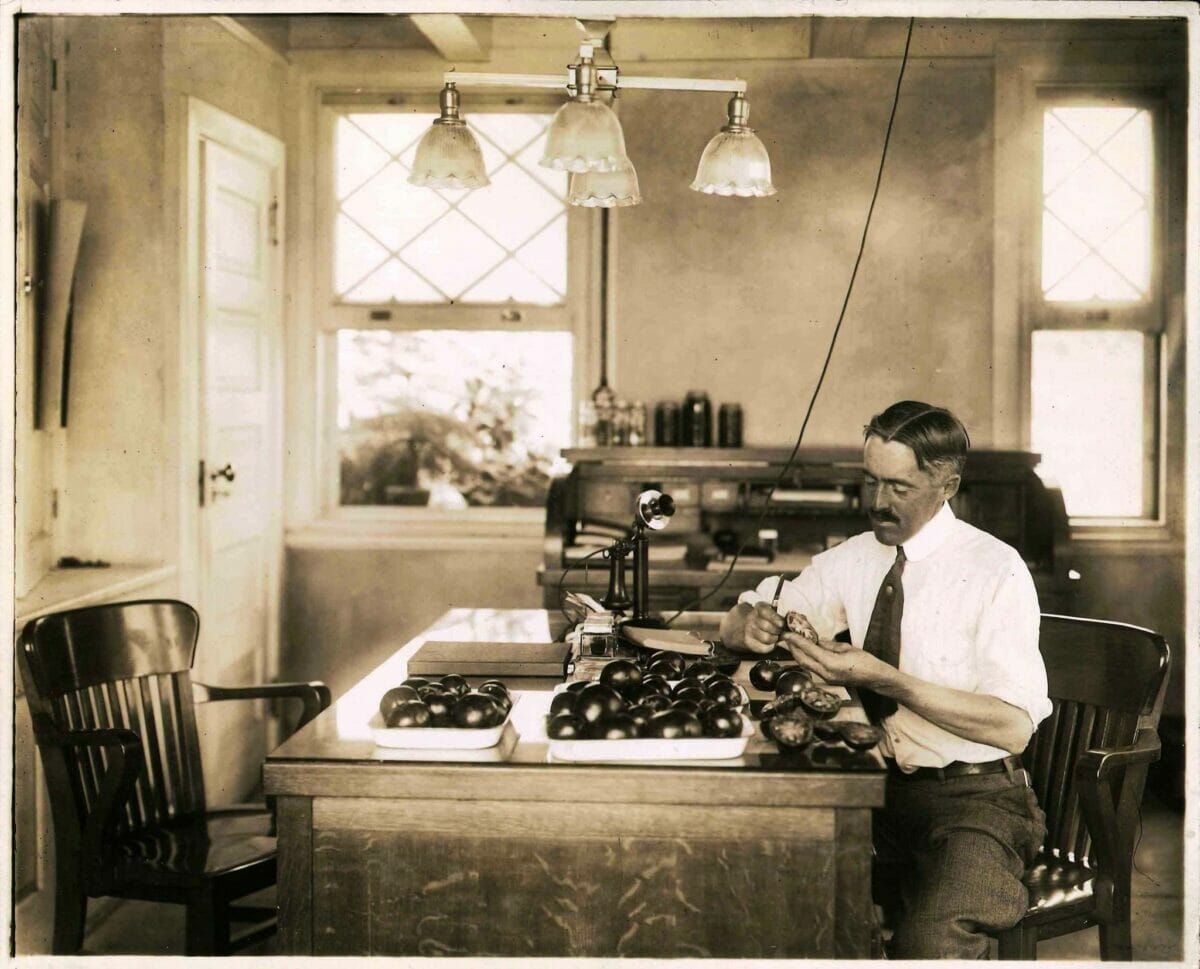
Harry Hall, Campbell's chief agricultural expert, inspects tomatoes in his office at Campbell's research farm in Cinnaminson, New Jersey sometime in the 1920s.courtesy of Campbell Soup Company.
What comes to mind when you think of Campbell Soup? You might picture cans of tomato soup or perhaps an iconic Andy Warhol print of them. You probably don’t think much about the ingredients that went into those cans.
But Campbell’s did, and it bet big and early on agriculture research to grow its product offerings. One of the company’s biggest contributions to the agricultural space was its tomato breeding program, launched in 1910 in Cinnaminson, New Jersey, which involved conducting field experiments in an effort to breed different varieties for taste, production and disease resistance. A tomato research facility, added in 1937, was responsible for developing notable varieties such as the J.T.D., the Garden State and Rutgers tomato—and helped put New Jersey on the map as an important tomato-growing state.
Headquartered in Camden, New Jersey, Campbell’s once sourced most of its tomatoes from local farms. The Garden State has 24 different soil types, and most of them are good for farming. The prime growing area for Jersey tomatoes is a region now known as the Inner Coastal Plain, which covers more than 1,000 square miles in southern New Jersey, bordering the Delaware River to the west. The soil here consists of loams and sandy loam and is ideal for truck farms and high production of crops. Located within this prime growing area, Campbell’s was positioned well enough to double down on its bet that agricultural research would fuel its condensed soup products.
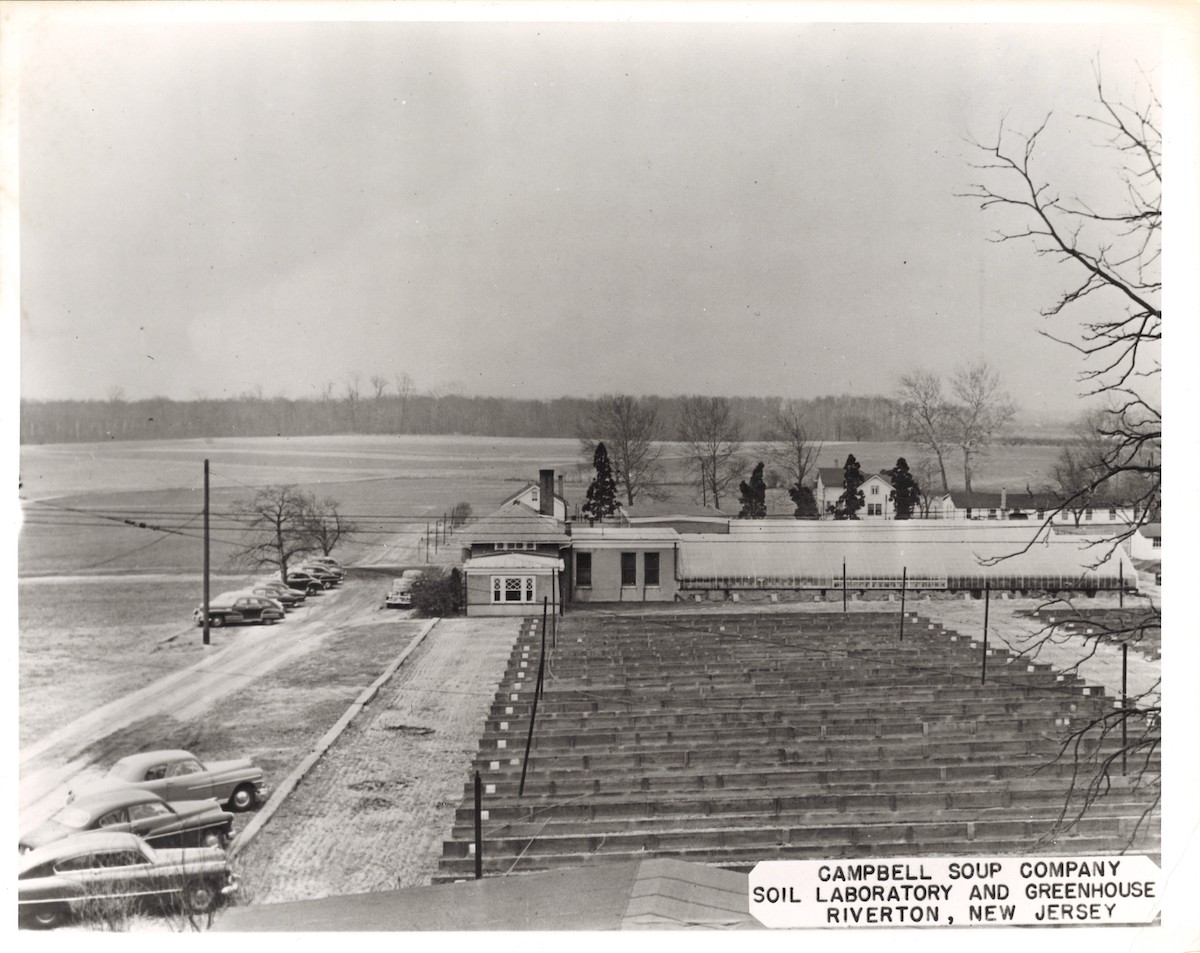
Tomato production in New Jersey can be traced to 1812, when tomato grower John Loper farmed on land owned by Ephraim Buck in Cumberland County. Tomatoes at that time were still feared by some—a nickname for the fruit was “poisonous apple.” There’s a story about how Robert Johnson of Salem, New Jersey stood on the town’s courthouse steps and publicly ate a tomato to prove that it was safe; however, there’s no actual documentation it actually happened. (Don’t tell the residents of Salem though, who, in 2021, revived an annual tomato festival that at one time was named for Johnson and includes a reenactment of the local legend eating a tomato.)
As the 1800s rolled on, and people overcame their fear of tomatoes, the savory red fruit started to catch on as a commercial crop. The canning industry was growing in New Jersey, with tomatoes making up a part of the mix of crops canned. In the 1860s, the rapid commercialization of tomato ketchup as a consumer product propelled the farming of tomatoes, especially in South Jersey, a core ketchup production area. The Campbell Soup Company was originally founded as the Joseph A. Campbell Preserve Company in 1869. In the 1870s, the company started to market its new Beefsteak Tomato Ketchup.
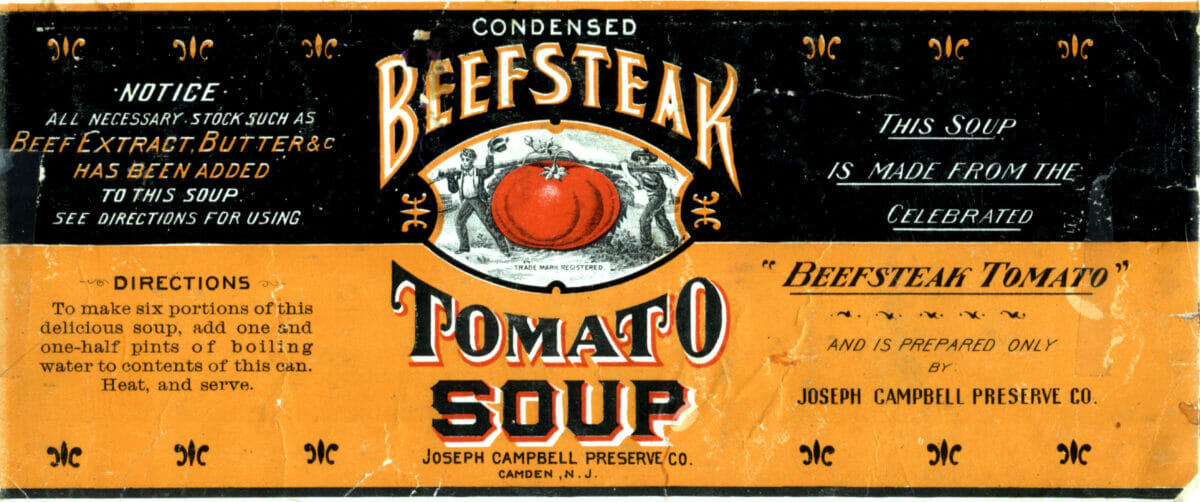
By 1910, when the company launched its tomato breeding program, Campbell’s had undergone a name change and released its signature ready-to-eat Beefsteak Tomato soup. The following year, the company achieved national distribution, and it needed more tomatoes to meet the demand.
One of the tomatoes Campbell’s bred was the Rutgers tomato, which traces its lineage back to the man who invented the condensed soup process, John Thompson Dorrance, when he was an employee of Campbell’s. He would later go on to become president of the company. The J.T.D. tomato, named after him, was released in 1918 and was likely bred on the farm where Dorrance lived. The J.T.D. tomato is a medium-sized red tomato averaging in the eight-to-12-ounce range. It’s uniform in shape, tasty and doesn’t crack. Campbell’s was looking to standardize its harvest with tomatoes that were a consistent size and shape, as well as taste- and blemish-free, as its production needs increased.
The J.T.D. tomato, while important to New Jersey, was even recognized on the national level. In the 1937 USDA Yearbook of Agriculture, it was described as “an interesting example of a local type developed for adaptation to a specific set of conditions and needs. It was developed by the Campbell Soup Co. for growing in New Jersey, mainly for its own factory use. It has not become widely grown elsewhere.” This work is a big contributor to the iconic status of the Jersey tomato.
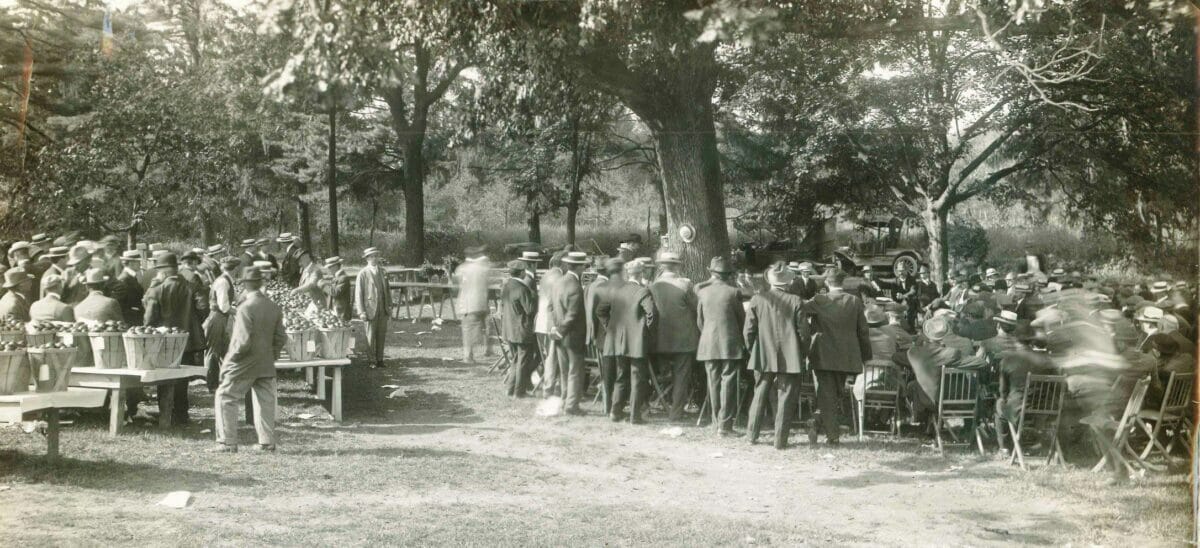
In 1928, the J.T.D. tomato was used in a breeding program for what has become the most popular Jersey heirloom tomato, the Rutgers. To create it, the J.T.D. was crossed with the Marglobe, a disease-resistant and historic tomato developed by Frederick John Pritchard while at the USDA’s Plant Industry Bureau. The Marglobe has a strong disease resistance to Fusarium wilt and Nailhead rust, which plagued Florida tomato growers. Once the Marglobe was introduced, it just about saved the Florida tomato industry.
Once Campbell’s crossed the Rutgers tomato, the company handed it off to professor Lyman Schermerhorn of the Rutgers New Jersey Agricultural Experiment Station (NJAES). Schermerhorn did field trials for the next six years, making selections of the best plants. The Rutgers tomato was released in 1934, and it soon proved its worth as a processing tomato and one of adaptability.
As Andrew Smith details in his book Souper Tomatoes, 72 percent of commercial growers in the United States once planted the Rutgers tomato. That’s a significant share of the market. It was used by Hunt’s and Heinz, as well as the Jersey-based PJ Ritter Company, a national food processor and tomato seed company in the 1950s.

But not long after the Rutgers tomato was introduced, tomato farming practices started to change. As harvesting became more mechanized, the thin-skinned Rutgers tomato plummeted in popularity with farmers, who were looking for heartier tomatoes that would last longer. When that happened, the Rutgers tomato lost favor as a canning tomato.
“The significance of the original Rutgers to the history of the modern tomato was mostly lost during the 1950s and 1960s as the industry moved to F1 hybrid cultivars and mechanical harvesting of processing types that are currently used in prepared soups and sauces,” says Tom Orton, a professor in the department of plant biology and pathology at Rutgers University who retired last year. “The original developer of Rutgers, Lyman Schermerhorn, also retired during the 1950s and most of the germplasm he developed during his career, including Rutgers breeding lines, was lost.”
In 2010, Orton and a team of researchers started working on the Jersey Tomato Project in an effort to revive the Rutgers variety, which was believed to be lost to history. They soon learned, however, that Campbell’s still had some original seed stocks used to develop the original Rutgers variety stored away in a vault. In 2016, the researchers were able to debut a re-bred version: the Rutgers 250, which coincided with the 250th anniversary of Rutgers University.
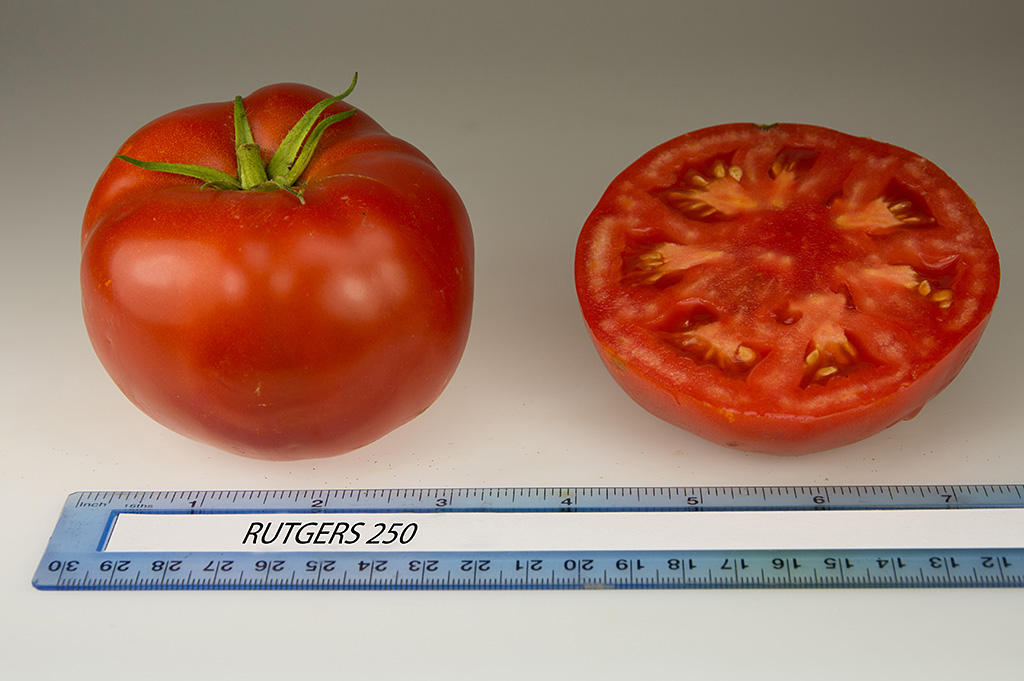
It’s great that Campbell’s had preserved the original seeds so this historic tomato could be reintroduced. Other tomato seeds were discovered, too, which the Rutgers researchers grew out as well. One of those was the KC-146, which, according to Cindy Rovins of NJAES, was developed by Campbell’s for the production of tomato juice and later used as a flavor standard as it continued to develop newer varieties.
Another Campbell’s tomato, the Garden State, was introduced by Campbell’s in 1947. In the Campbell’s naming convention, it’s also known as Campbell’s 37 or KC-37. Bred from Pink Topper, Marvel and Pritchard, the seeds are not easy to find, although they were donated to the USDA Germaplasm Bank in 1960.
It’s ironic that the seeds of a tomato named for the nickname of a state known for its Jersey tomatoes, which was part of a historic breeding program, are not more widely available. Campbell’s was in the food production business, not the seed business, so seeds were not released to commercial seed companies. As the USDA noted in its evaluation of the J.T.D., Campbell’s tomatoes were mainly for their factory use—not for backyard gardeners or tomato enthusiasts.
The Garden State tomato, like many other varieties that Campbell’s was responsible for developing, is a fine-tasting tomato. It’s no wonder that Campbell’s tomato soup took its storied place in American culture, cementing itself even further when Andy Warhol painted his iconic Campbell’s Soup Can series that debuted in 1962.
Warhol once said of Campbell’s soup: “I used to drink it. I used to have the same lunch every day, for 20 years, I guess, the same thing over and over again.” In the two decades that he drank his lunch, Warhol tasted iconic Jersey tomatoes like everyone else did. Unbeknownst to any of them, they were consuming the fruits of a historic and innovative tomato breeding program.
Jeff Quattrone is the founder of Library Seed Bank, an artist and seed activist who is working to preserve local food biodiversity through seed libraries.
Follow us

This work is licensed under a Creative Commons Attribution-NoDerivatives 4.0 International License.
Want to republish a Modern Farmer story?
We are happy for Modern Farmer stories to be shared, and encourage you to republish our articles for your audience. When doing so, we ask that you follow these guidelines:
Please credit us and our writers
For the author byline, please use “Author Name, Modern Farmer.” At the top of our stories, if on the web, please include this text and link: “This story was originally published by Modern Farmer.”
Please make sure to include a link back to either our home page or the article URL.
At the bottom of the story, please include the following text:
“Modern Farmer is a nonprofit initiative dedicated to raising awareness and catalyzing action at the intersection of food, agriculture, and society. Read more at <link>Modern Farmer</link>.”
Use our widget
We’d like to be able to track our stories, so we ask that if you republish our content, you do so using our widget (located on the left hand side of the article). The HTML code has a built-in tracker that tells us the data and domain where the story was published, as well as view counts.
Check the image requirements
It’s your responsibility to confirm you're licensed to republish images in our articles. Some images, such as those from commercial providers, don't allow their images to be republished without permission or payment. Copyright terms are generally listed in the image caption and attribution. You are welcome to omit our images or substitute with your own. Charts and interactive graphics follow the same rules.
Don’t change too much. Or, ask us first.
Articles must be republished in their entirety. It’s okay to change references to time (“today” to “yesterday”) or location (“Iowa City, IA” to “here”). But please keep everything else the same.
If you feel strongly that a more material edit needs to be made, get in touch with us at [email protected]. We’re happy to discuss it with the original author, but we must have prior approval for changes before publication.
Special cases
Extracts. You may run the first few lines or paragraphs of the article and then say: “Read the full article at Modern Farmer” with a link back to the original article.
Quotes. You may quote authors provided you include a link back to the article URL.
Translations. These require writer approval. To inquire about translation of a Modern Farmer article, contact us at [email protected]
Signed consent / copyright release forms. These are not required, provided you are following these guidelines.
Print. Articles can be republished in print under these same rules, with the exception that you do not need to include the links.
Tag us
When sharing the story on social media, please tag us using the following: - Twitter (@ModFarm) - Facebook (@ModernFarmerMedia) - Instagram (@modfarm)
Use our content respectfully
Modern Farmer is a nonprofit and as such we share our content for free and in good faith in order to reach new audiences. Respectfully,
No selling ads against our stories. It’s okay to put our stories on pages with ads.
Don’t republish our material wholesale, or automatically; you need to select stories to be republished individually.
You have no rights to sell, license, syndicate, or otherwise represent yourself as the authorized owner of our material to any third parties. This means that you cannot actively publish or submit our work for syndication to third party platforms or apps like Apple News or Google News. We understand that publishers cannot fully control when certain third parties automatically summarize or crawl content from publishers’ own sites.
Keep in touch
We want to hear from you if you love Modern Farmer content, have a collaboration idea, or anything else to share. As a nonprofit outlet, we work in service of our community and are always open to comments, feedback, and ideas. Contact us at [email protected].by Jeff Quattrone, Modern Farmer
January 12, 2022
Modern Farmer Weekly
Solutions Hub
Innovations, ideas and inspiration. Actionable solutions for a resilient food system.
ExploreExplore other topics
Share With Us
We want to hear from Modern Farmer readers who have thoughtful commentary, actionable solutions, or helpful ideas to share.
SubmitNecessary cookies are absolutely essential for the website to function properly. This category only includes cookies that ensures basic functionalities and security features of the website. These cookies do not store any personal information.
Any cookies that may not be particularly necessary for the website to function and are used specifically to collect user personal data via analytics, ads, other embedded contents are termed as non-necessary cookies.
We had the best tomatoes 🍅 n still grow the best Tomato 🍅 Love the Article n History of NJ Tomatoes 🍅
Noted environmental analyst Lester Brown of the Worldwatch and Earth Policy Institutes writes about his days of farming tomatoes in New Jersey. There are still many farmers in Southern Appalachia growing tomatoes. But one wonders how long these farmers will be able to farm with the onset of industrial tomatoes being raised within factory walls by people like Jonathon Webb and his team of New York City investors.
Very interesting story. Just ordered the book Souper Tomatoes.
I grew up in Salem, two blocks from the Heinz factory that produced the ketchup that perfumed our town all summer long. The trucks bearing stacked baskets full of the warm, ripe fruit would drop some of their bounty when stopping and starting at the traffic light by my family home. There were nearly always some children waiting for this treasure to fall, salt shakers at the ready. No tomato has ever tasted better!
What comes to mind when I think of Campbell’s Tomato Soup? Sugar. It’s the number three ingredient (behind water and tomatoes). There’s no place for sugar in my soup.
my step father was a ob/gyn doctor in Wilmington, DE. He had patients who crossed the Delaware Memorial Bridge from southern NJ and would bring him Campbell’s tomatoes as grateful patient gifts. I remember occasionally tasting them at the end of the summer. Delicious.
Great article! BTW Loved writing Souper Tomatoes: The Story of America’s Favorite Food (Rutgers University Press, 2000). It was the final book in my tomato trilogy — the other two being The Tomato in America: Early History, Culture and Cookery (University of South Carolina Press, 1994) and Pure Ketchup: A History of America’s National Condiment (University of South Carolina Press, 1996).
Great article.
enjoyed your article! my grandparents sold alot of their tomatoes to Campbells soup, too. they were the Donald farm in Burlington Twp. on the Bustleton Rd.
SSC 1981